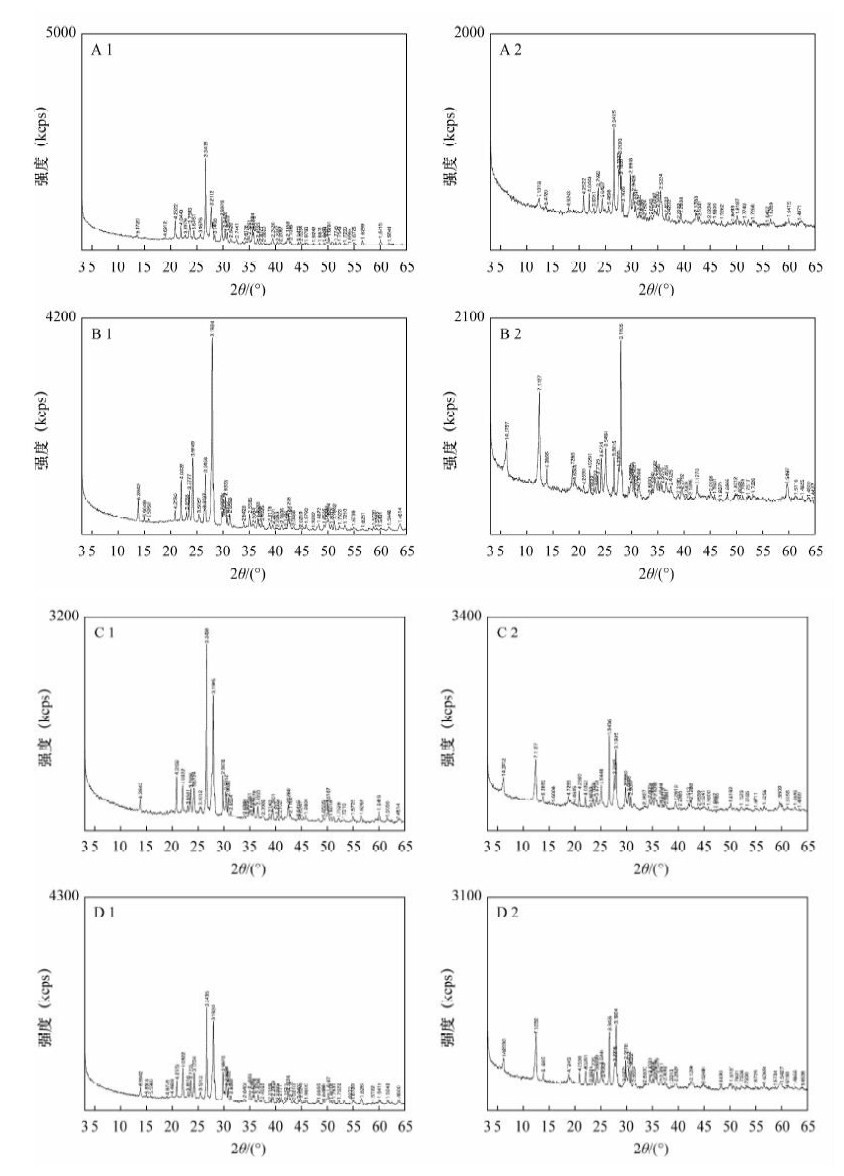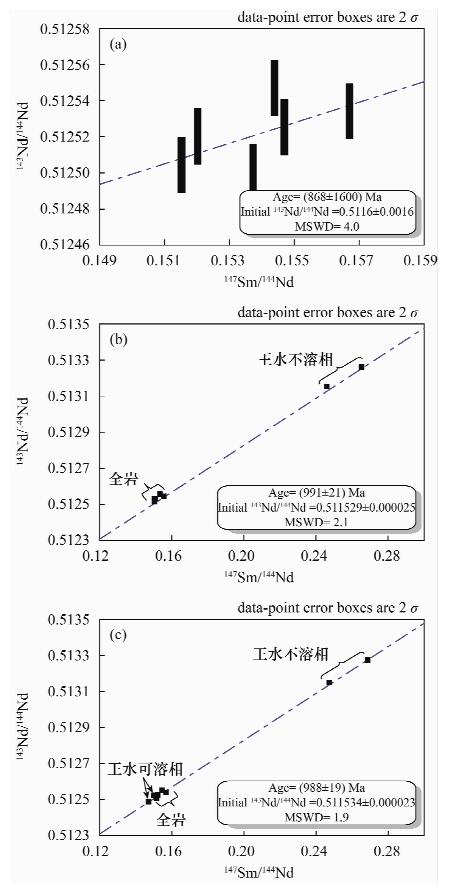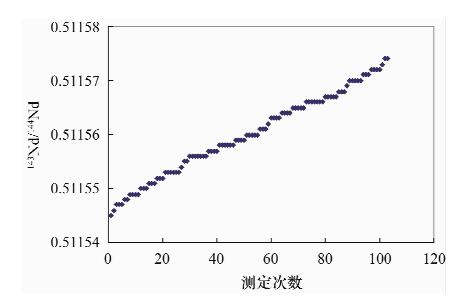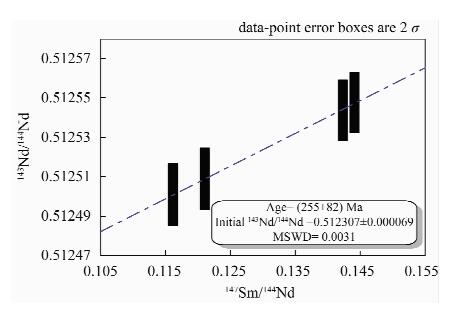Procedure for Sm-Nd Internal Isochron Dating Method on Basalt by Phase Separation
-
摘要:
长期以来,对玄武岩精确测年一直是困扰地质学家的重大科学问题。玄武岩结构和组成特殊,岩石中矿物组成单一、锆石十分稀少,颗粒很细,采用物理方法挑选单矿物和锆石十分困难,很难应用内部等时线法和锆石U-Pb法研究其成岩时代。而全岩样品间因岩浆分异产生的147Sm/144Nd比值差别很小,等时线年龄相对误差较大;Rb含量很低,Rb/Sr比值很小,全岩Sm-Nd法、Rb-Sr法常常不能给出正确可信的年龄。根据内部等时线法原理,本文通过化学方法,采用王水和氢氟酸-硝酸对玄武岩样品进行分步溶解,分别对同一件样品的王水溶解相、王水不溶相和全岩开展Sm-Nd同位素组成分析。结果表明:通过不同酸介质分步溶解,可提取玄武岩中石英、透辉石、长石等矿物组合,该组合与其全岩具有相同的εNd(t)和一致的Nd同位素模式年龄;矿物与全岩构筑的内部等时线中,147Sm/144Nd比值的变化由全岩之间的0.005扩大到0.11,143Nd/144Nd值的变化由全岩的0.512500~0.512547扩大到0.512500~0.513145。通过该方法获得了与已有锆石U-Pb年龄在误差范围内一致的Sm-Nd等时线年龄:t=(991±21)Ma(MSWD=2.1)。通过对比研究,本文认为:玄武岩分相Sm-Nd内部等时线定年方法,适用于前寒武纪及更古老的玄武岩样品的年龄测定。该方法的建立不仅有效提高玄武岩Sm-Nd等时线定年成功率,也为其他隐晶质且不易挑出单矿物样品的年龄测定提供了新的思路。
Abstract:Accurately dating the age of basalt has been an important scientific issue for geologists. Due to its unique texture and composition, the basaltic minerals are limited to certain types, with scarce zircons in tiny grain sizes. It is difficult to pick pure minerals such as zircon from basalt in physical ways, therefore, studying the formation age of basalt by internal isochron or zircon U-Pb methods is challenging. Since whole rock basalt samples, on the other hand, have a limited range of 147Sm/144Nd ratios, low Rb content and low Rb/Sr ratio, the whole rock Sm-Nd method or Rb-Sr method usually cannot yield an accurate age. In this study, the principle of internal isochron and chemical methods, using aqua regia and Hf-HNO3 to dissolve the same basalt samples by steps is utilized, and performed by Sm-Nd isotopic analysis on the 3 phases from the same sample: 1) dissolved phase in aqua regia, 2) undissolved phase in aqua regia and 3) whole rock phase. The results shows that, through dissolving the samples in different acid media by steps, quartz-diopside-feldspar mineral assemblage can be extracted from basalt, and this assemblage has the same εNd(t) and Nd modal age as the whole rock. In the internal isochron constructed by minerals and whole rock, the variation range of 147Sm/144Nd ratio increases from 0.005 within the whole rock to 0.11, the 143Nd/144Nd ratio range varies from 0.512500-0.512547 within the whole rock to 0.512500-0.513145. The Sm-Nd age yielded with this method is identical to previous zircon U-Pb age within uncertainty: t=(991±21) Ma, MSWD=2.1. By comparing the results from conditional experiments, we propose that Sm-Nd internal isochron dating by phase separation is more suitable for rock samples of Precambrian or older. The establishment of this method can effectively increase the success of Sm-Nd isochron dating for basalt, as well as offer a new estimate for other aphanitic rock samples that cannot provide pure minerals for easy dating.
-
Key words:
- basalt /
- dissolve by steps /
- phase separation /
- Sm-Nd isotope /
- geochronology /
- internal isochron
-

-
表 1 静态多接收质谱仪(TRITON)杯结构
Table 1. Cup structure of the static multi-collectors mass spectrometer (TRITON)
杯位置 质量数 同位素 杯位置 质量数 同位素 L3 142 142Ce+142Nd H1 146 146Nd L2 143 143Nd H2 147 147Sm L1 144 144Nd+144Sm H3 149 149Sm C 145 145Nd 表 2 玄武岩王水不溶相及全岩X射线粉晶衍射半定量分析结果
Table 2. Semi-quantitive results of X-ray powder diffraction analysis of the insoluble phase in aqua regia and whole-rock basalt
样品 对应图 1的序号 矿物含量(%) 石英 透辉石 长石 绿泥石 高岭石 EQB(王水不溶相) A1 32 49 19 0 0 SNJ27(王水不溶相) B1 16 73 11 0 0 SNJ29(王水不溶相) C1 44 37 19 0 0 SNJ35(王水不溶相) D1 34 44 22 0 0 EQB(全岩) A2 20 56 19 0 5 SNJ27(全岩) B2 12 45 8 35 0 SNJ29(全岩) C2 27 33 15 25 0 SNJ35(全岩) D2 22 32 21 20 5 表 3 玄武岩样品及BCR-2标样的Sm-Nd同位素分析结果
Table 3. The Sm-Nd isotopic composition of basalt powder and BCR-2 standard samples dissolved with different acid media
样号 类型 147Sm/144Nd 143Nd/144Nd(±2σ) tDM(Ga) 2DMt(Ga) Ndε(t) SNJ25-1f 王水不溶相 0.2452 0.513132±13 -0.09 1.43 2.81 SNJ 25-2f 王水不溶相 0.2472 0.513145±20 -0.02 1.43 2.79 SNJ 35-1f 王水不溶相 0.2666 0.513254±15 0.30 1.47 2.18 SNJ 35-2f 王水不溶相 0.2692 0.513264±21 0.31 1.49 2.01 SNJ 25 全岩 0.1516 0.512520±9 1.54 1.34 4.08 SNJ 25s 全岩 0.1521 0.512522±9 1.55 1.35 3.99 SNJ 35 全岩 0.1545 0.512547±7 1.55 1.34 4.18 SNJ 27 全岩 0.1568 0.512534±8 1.65 1.38 3.60 SNJ 29 全岩 0.1516 0.512504±12 1.58 1.37 3.75 SNJ07-26-1 全岩* 0.1548 0.512525±2 1.61 1.37 3.7 SNJ07-26-2 全岩* 0.1538 0.512500±1 1.65 1.39 3.4 SNJ 25-1c 王水可溶相 0.1466 0.512486±13 1.51 1.29 3.33 SNJ 25-2c 王水可溶相 0.1471 0.512483±13 1.52 1.30 3.21 SNJ 35-1c 王水可溶相 0.1509 0.512511±9 1.55 1.30 3.26 SNJ 35-2c 王水可溶相 0.1500 0.512519±12 1.51 1.31 3.13 EQB 全岩 0.1210 0.512509±6 1.05 0.91 0 EQB-c 王水可溶相 0.1161 0.512501±10 1.01 0.91 0.003 EQB-c 王水可溶相 0.1160 0.512501±9 1.01 0.92 0.007 EQB-f 王水不溶相 0.1440 0.512548±8 1.31 0.75 0.013 EQB-f 王水不溶相 0.1422 0.512544±10 1.29 0.72 -0.04 BCR-2 标准推荐值 0.1382 0.512636±2** 1.04 0.76 1.08 BCR-2 本文测定值 0.1376 0.512633±4 1.04 0.73 1.15 BCR-2-1c 王水可溶相 0.1306 0.512620±7 0.97 0.76 0.91 BCR-2-2c 王水可溶相 0.1311 0.512641±2 0.94 0.76 1.31 BCR-2-1f 王水不溶相 0.1534 0.512637±12 1.30 1.11 0.81 BCR-2-2f 王水不溶相 0.1550 0.512644±14 1.31 1.12 0.92 *snj07-26-1值引自文献[24];**BCR-2值引自GeoRem (http://georem.mpch-mainz.gwdg.de),其147Sm/144Nd值根据Sm、Nd浓度为计算得出。tDM年龄采用文献[25]线性模式计算,t2DM年龄采用李献华等[26]两阶段模式计算。 表 4 143Nd/144Nd值测定时144Sm干扰监控值
Table 4. 143Nd/144Nd values determined with 144Sm disturbance monitoring
扫描次数 145Nd/144Nd 143Nd/144Nd 142Nd/144Nd 147Sm/144Nd 1 0.348494 0.512494 1.18694 2.06673×10-5 2 0.348448 0.52464 1.17460 -2.38687×10-6 3 0.348457 0.512523 1.17036 1.22418×10-5 4 0.348441 0.512551 1.16671 6.49628×10-5 5 0.348457 0.512536 1.16378 1.23097×10-5 6 0.348446 0.512468 1.16127 1.45124×10-5 7 0.348440 0.512564 1.15936 8.56490×10-6 8 0.348452 0.512519 1.15771 1.43829×10-5 9 0.348424 0.512496 1.15629 1.44144×10-6 10 0.348451 0.512520 1.15491 2.77971×10-6 11 0.348432 0.512567 1.15401 1.37760×10-6 12 0.348436 0.512564 1.15304 9.42705×10-6 13 0.348430 0.512509 1.15222 1.96576×10-5 14 0.348412 0.512510 1.15137 2.12260×10-5 平均值 0.348440 0.512520 1.15966 1.01927×10-5 -
[1] [2] [3] [4] [5] Pearce J A. Role of the sub-continental lithosphere in magma genesis at active continental margins[C]// Hawkesworth, Norry. Continental Basalts and Mantle Xenoliths. Nantwich: Shiva, 1983: 230-249.
[6] [7] [8] [9] [10] [11] [12] [13] [14] [15] Farmer G L, DePaolo D J. Source of hydrothermal com-ponents: Heavy Isotopes[M]//Barnes H L. Geochemistry of Hydrothermalre Deposits (Third Edition). New Jersey: John Wiley & Sons, 1997: 31-41.
[16] [17] [18] [19] [20] [21] [22] [23] [24] [25] [26] [27] [28] Ludwig K R. Isoplot/Ex, rev. 2. 49. A Geochronological Toolkit for Microsoft Excel[M]. Berkeley Geochronology Center, 2001: 56.
[29] [30] [31] [32] [33] [34] [35] [36] -




 下载:
下载:


